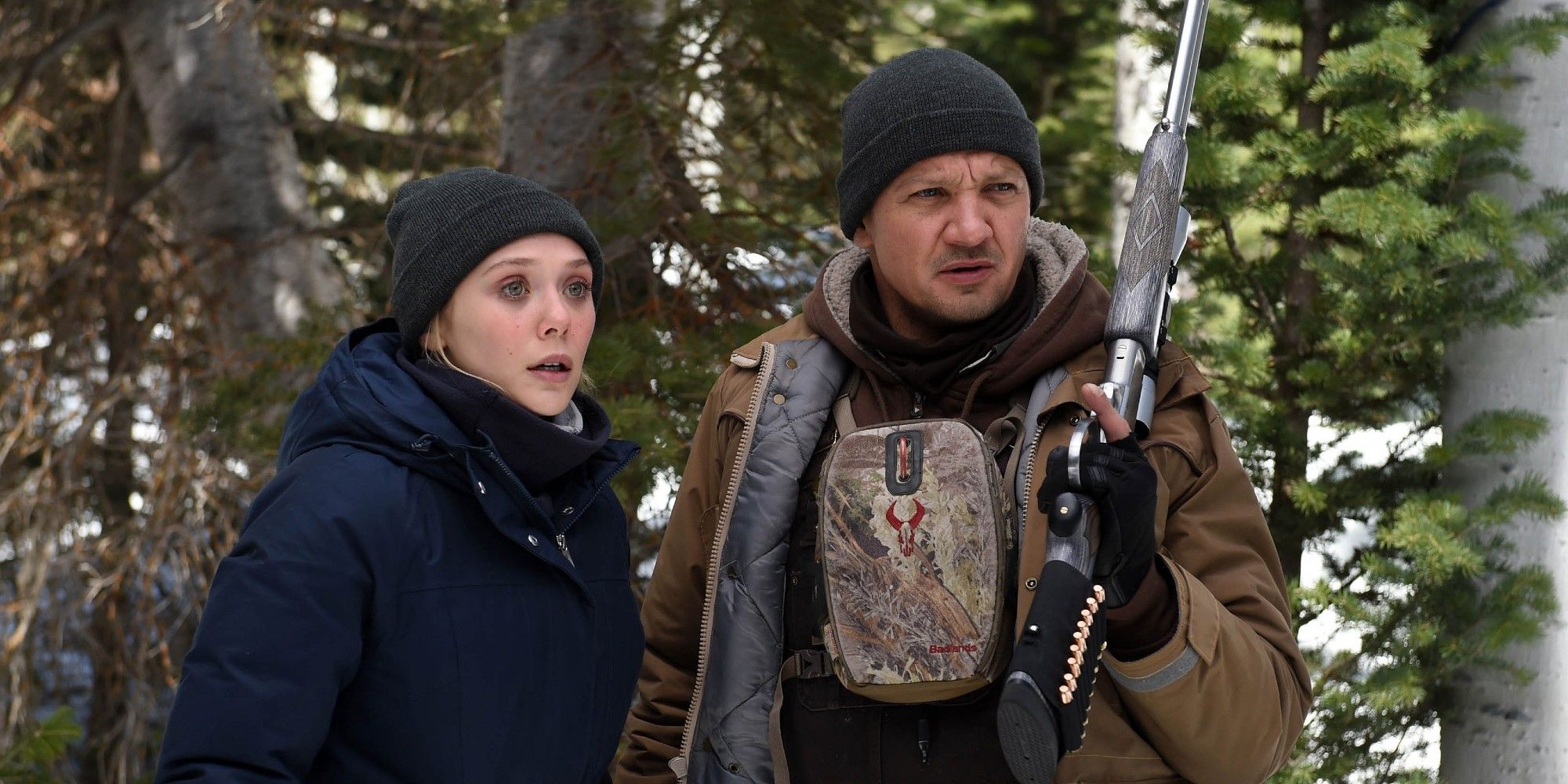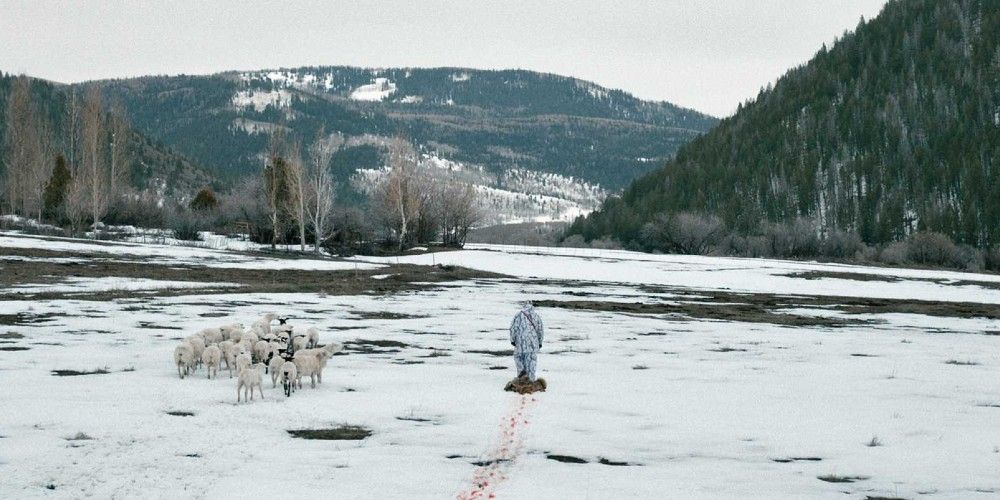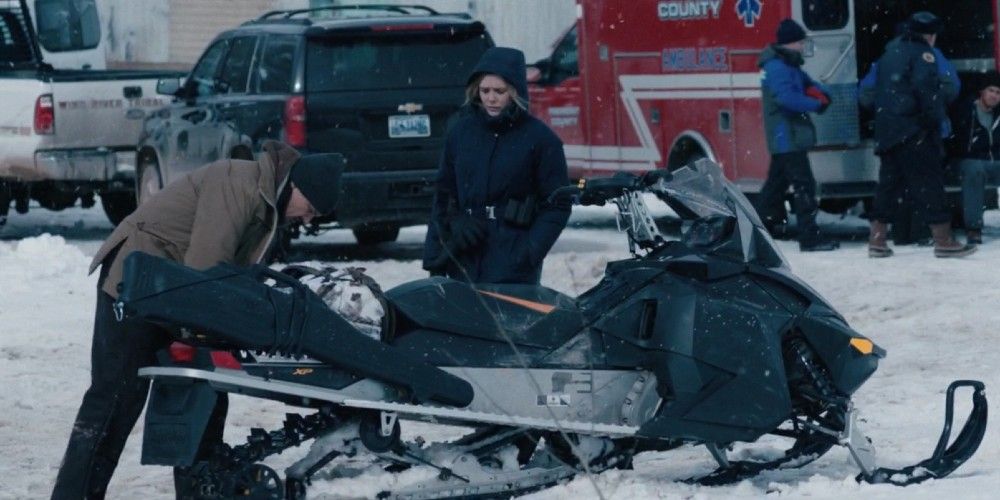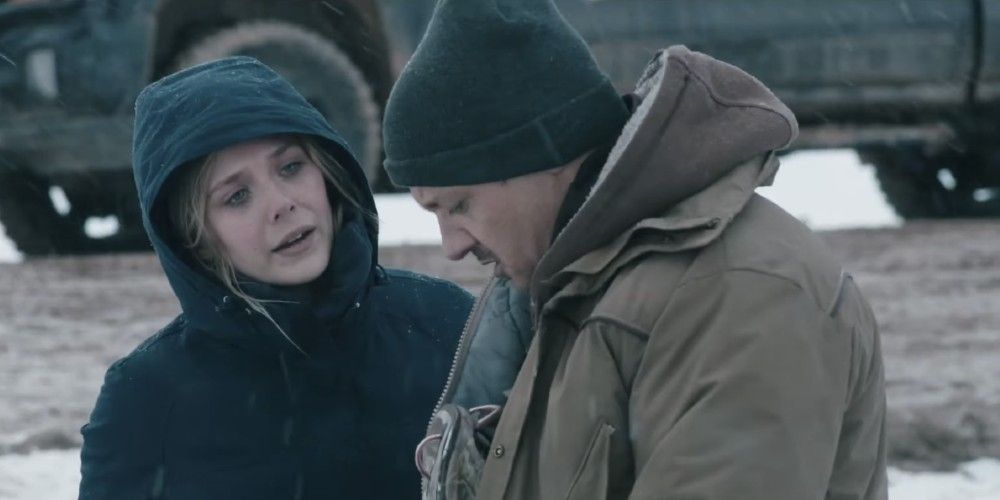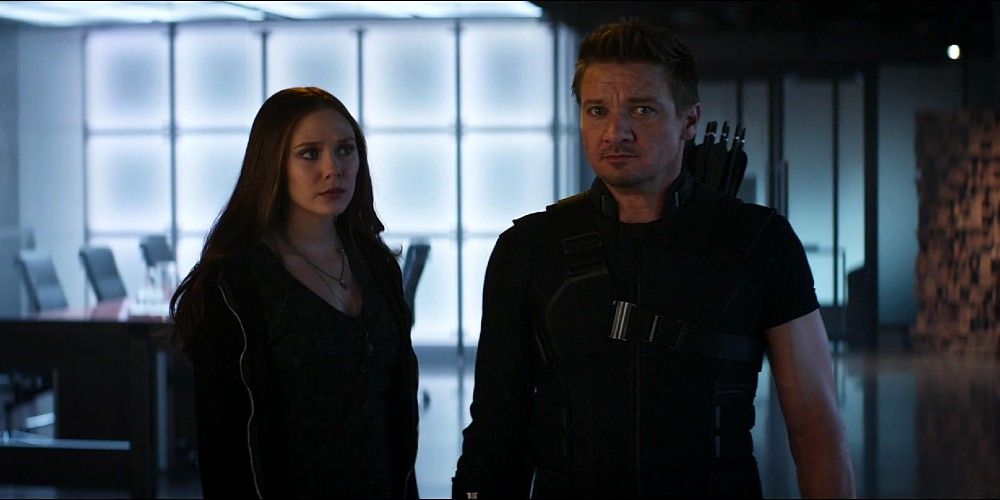Hawkeye and Scarlet Witch have a close relationship. In Marvel Comics, Hawkeye harboured feelings for Wanda, despite her ultimately marrying her synthezoid soul-mate Vision. In the MCU, Jeremy Renner’s Clint Barton is the one who motivates Elizabeth Olsen’s Wanda to join the fight in Avengers: Age of Ultron (2015), and also in Captain America: Civil War (2016). The two even share a small moment together in Avengers: Endgame (2019) when mourning the loss of Black Widow and Vision respectively. But between these franchise hits, the two Marvel stars tamed up for the bleak mid-budget mystery Wind River (2017).
This film bears little resemblance with the colourful superhero blockbusters, except for perhaps Jeremy Renner remaining an expert marksman, playing tracker and “Fish and Wildlife Serviceman” Cory Lambert, who patrols the icy Wyoming “Wind River Indian Reservation.” Lambert discovers the frozen body of 18-year-old Native American Natalie Hanson (Kelsey Chow), who is half-naked, bloodied and barefoot, miles from any shelter in this winter wasteland.
FBI Agent Jane Banner (Elizabeth Olsen) is called up to investigate her death, but matters are complicated by bureaucratic mismanagement which awkwardly splits the Reservation between FBI and “Tribal Police Chief” jurisdiction, leading to simmering tension of whose authority governs this land. Additionally, the coroner cannot “technically” call Natalie’s death a homicide, despite obvious abuse and trauma, given she died from exposure to the sub-zero environment instead of her wounds. It’s as if the vast snowy tundra is determined to swallow her up into non-existence.
Lambert has a personal connection to the case, not only knowing the family beforehand but also as his own, half-Native daughter was also found dead in the snow three years ago. The killer was never caught. Natalie’s “invalid” cause-of-death means the inexperienced Agent Banner cannot request FBI back-up or further resources and has a limited time frame to scavenge the Reservation before being called back. She and Lambert must work against the clock to close this case, determined to not let another Native American woman – a group disproportionately affected by violence – become another statistic that falls through the cracks.
There’s a fair critique that issues surrounding marginalized communities shouldn’t be helmed by white people, both in front of and behind the camera. Whilst Wind River mourns the violence against Native Women, it doesn’t deeply probe the systemic issues that cause their disproportionate disenfranchisement, nor give them much more roles than victims for the two government leads – a government who contributes to their suffering – to get revenge for.
But Wind River isn’t completely unaware of its racial dynamics, such as when Lambert’s half-Arapaho son beams at him, after steering a horse, “pretty cowboy, huh?” to which Lambert replies, “No, son, it’s a whole lot Arapaho.” And although the two Marvel stars draw the Box Office in, Wind River does defer to and uplift (albeit to a limited extend) great indigenous character actors like Graham Greene (as Ben Toyo, the Tribal Police Chief) and Gill Birmingham (as Natalie’s grieving father, Martin).
Birmingham also appeared in Wind River’s writer-and-director Taylor Sheridan’s previous written film, Hell of High Water (2016), directed by David Mackenzie. Although that film primarily concerns two brothers (Chris Pine and Ben Foster) robbing banks to save their family ranch while being pursued by two Texas Rangers (Birmingham and Jeff Bridges), it also includes Birmingham describing cycles of “stolen land,” and wild outlaw Tanner (Foster) communing with a “Camanche.”
Native Americans are a foundational part of Westerns, but traditionally as a racist, reductive enemy. Sheridan wishes to reframe their involvement, with Wind River concluding his loose neo-Western “frontier trilogy,” which began with Sicario (2015) – directed by Denis Villeneuve – and Hell of High Water continued. The films form bleak and uncompromising looks at what laws and civilizations mean in lands governed by greed and violence.
Wind River grapples this frontiersman mentality in an area where “snow and silence are the only things that haven’t been taken,” as Lambert and Banner navigate the leads trailing back from Natalie’s death. One takes Banner to the trailer of Natalie’s boyfriend Matt (Jon Bernthal), a security guard for a drilling company, another entity exploiting Native American land. Without spoiling exactly what happens, this third-act sequence has Sheridan expertly and naturally manipulate all the key forces into opposing positions, crafting an insanely tense Mexican stand-off that escalates with blood-pumping tension. Between these peaks, Wind River remains a sturdy mystery, with cinematographer Ben Richardson beautifully capturing the expansive inhospitable landscapes. Nick Cave and Warren Ellis layer on a tense, haunting score that keeps Wind River rooted in its tragic circumstances.
Wind River balances its brittle neo-Western genre by infusing itself with character-driven drama, Lambert especially run ragged from the recent case digging up his family trauma. Sheridan grants Renner room to breathe and navigate these heavy emotions, with him acting more taciturn and professional in public, only for his old wounds to be slowly pried open over the film’s events. Gil Birmingham deserves special mention for his simmering rage which fizzles out into haunted despair. And Elizabeth Olsen is also impressive as Agent Banner, providing Wind River a necessary “outsider” perspective while making the role fuller than a female sidekick in a male-dominated world. Olsen brings genuine character to Banner, somebody out of her element, but capable of acclimatizing to it.
Our leads (spoiler alert) manage to close the case and “avenge” Natalie’s death. But Wind River understands such retribution is a hollow victory. The violence is not fun or cathartic, but a grueling mess that more often leaves victims whimpering half-alive in blood after they’ve been shot. For all their efforts, nothing will bring back Lambert’s daughter or Natalie, and the most they can reclaim is that they won’t be forgotten. Instead of triumph, Banner ends Wind River tearfully contemplating – in both horror and admiration – how Natalie “ran six miles in the snow” before quietly dying alone.
Wind River may get too hung-up with such bleakness. Its nihilistic outlook coalesces with Lambert’s silent, macho protection, framing his (failed) guardianship of Native American women as something tough but necessary, instead of a system he might need to fix. His speech that, in the dog-eat-dog Reservation “you survive or you surrender” promotes an ideology that leaves such tragedy up to the “natural order,” instead of actually investigating their underlying causes.
Plus, as a director, Sheridan doesn’t have the same restraint or visual stylization as his other “frontier trilogy” films. One particularly upsetting scene in Wind River outright portrays a previously implied brutal act that edges into exploitation. This grumbling world-weary mystery certainly won’t convert anyone uninterested in the genre – Hell or High Water has broader appeal and brings grander dignity – but Wind River remains a sturdy and uncompromising thriller that embodies Taylor Sheridan’s abilities.
Sheridan has a new film coming out on May 14th, Those Who Wish Me Dead, starring Angelina Jolie, who herself will enter the MCU with The Eternals later in 2021. Some may decry actors, even huge names like Jolie, “selling out” for superhero films. But the film industry has long held a contentious balance between being a “business” and selling “art.” Actors (much like working directors) require huge blockbusters both for their exposure, and to enable funding for smaller films.
Wind River’s $11 million budget pales in comparison to Avengers: Endgame’s $356 million, but such movies do not have to be opposed. Instead, they are part of the same ecosystem, Jeremy Renner and Elizabeth Olsen using their Marvel star-power to bolster Wind River ticket sales, whilst the film’s mature themes give them critical acclaim and serious range in return. It’s only because these two actors are Avengers, and gain the associated name recognition and professional freedom, that they can avenge the death in Wind River, and highlight the relevant real-world issues that the film touches upon.

